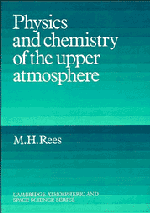Book contents
- Frontmatter
- Contents
- Preface
- Acknowledgements
- 1 An overview
- 2 The interaction of energetic solar photons with the upper atmosphere
- 3 The interaction of energetic electrons and ions with the upper atmosphere
- 4 Collisions and reactions
- 5 Ion and neutral composition of the upper atmosphere
- 6 Temperatures in the upper atmosphere
- 7 Spectroscopic emissions
- 8 Dynamics of the thermosphere and ionosphere
- Appendices
- Index
3 - The interaction of energetic electrons and ions with the upper atmosphere
Published online by Cambridge University Press: 04 April 2011
- Frontmatter
- Contents
- Preface
- Acknowledgements
- 1 An overview
- 2 The interaction of energetic solar photons with the upper atmosphere
- 3 The interaction of energetic electrons and ions with the upper atmosphere
- 4 Collisions and reactions
- 5 Ion and neutral composition of the upper atmosphere
- 6 Temperatures in the upper atmosphere
- 7 Spectroscopic emissions
- 8 Dynamics of the thermosphere and ionosphere
- Appendices
- Index
Summary
Solar UV radiation is the principal cause for the existence of the ionosphere and the physical processes that underlie the production of photoelectrons are presented in the preceding chapter. Since photoelectrons are produced within the atmosphere the term commonly applied to this population is an embedded source of ionization. We have not avoided the observational aspect of photoelectrons at this point, rather, a production rate is not a measurable quantity. Detectors measure the intensity or the flux, the number of particles or photons passing through or absorbed by unit area per unit time and solid angle. Photoelectron intensities will be derived in this chapter but, first, an additional source of ionization is discussed, a source that is due to energetic charged particle precipitation of solar and magnetospheric origin, associated principally with the aurora. Unlike photoelectrons, primary auroral electrons are a source external to the atmosphere and their intensity is a measurable quantity, analogous to the solar photon flux at the top of the atmosphere. Carrying the analogy one step further, the primary auroral electrons ionize the atmospheric gases producing secondary electrons that are the equivalent of the photoelectrons produced by photoionization.
In this chapter we first survey briefly the characteristics of energetic electron fluxes that have been measured by rocket and satellite borne detectors. We next analyse the processes that operate when a stream of energetic electrons penetrates into the atmosphere from the tenuous regions of the magnetosphere.
- Type
- Chapter
- Information
- Physics and Chemistry of the Upper Atmosphere , pp. 24 - 56Publisher: Cambridge University PressPrint publication year: 1989
- 3
- Cited by

